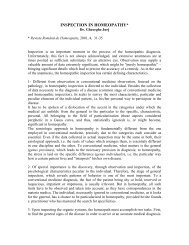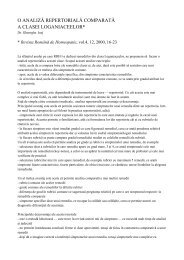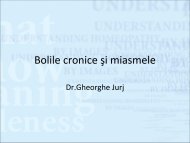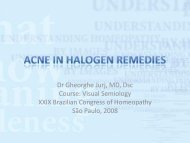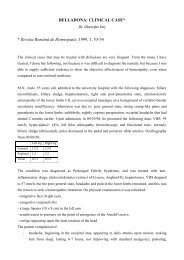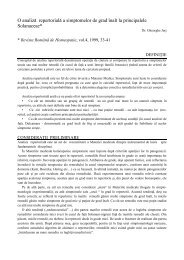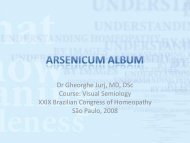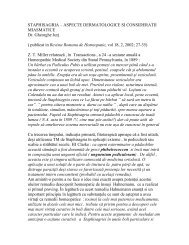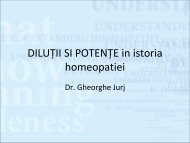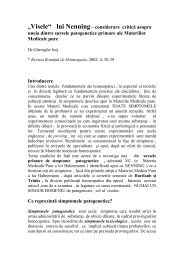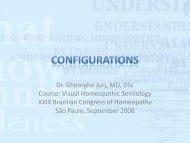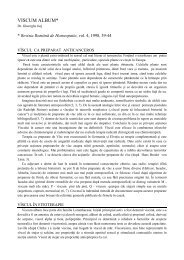Portrete homeopatice - Dr. Gheorghe Jurj - Homeopatie
Portrete homeopatice - Dr. Gheorghe Jurj - Homeopatie
Portrete homeopatice - Dr. Gheorghe Jurj - Homeopatie
- No tags were found...
Create successful ePaper yourself
Turn your PDF publications into a flip-book with our unique Google optimized e-Paper software.
* Revista Română de <strong>Homeopatie</strong>, 1999, 3, 46HOMEOPATHIC PORTRAITS<strong>Dr</strong>. <strong>Gheorghe</strong> <strong>Jurj</strong>I am persuaded that all who have learned or learn homeopathy appreciate the portrait descriptions ofremedies, where they appear as persons with well defined psychological and behavioral traits,desires and aversions, a story of personal trauma and pathology. Due to such descriptions, ourremedies have become images of „persons”, and it is not small the number of those who believethat the only duty of the homeopath is to identify each patient in a bookish description. The patientmust be... a remedy, when it is finally established, „he is Lycopodium”, “she is Ignatia”, everythingis clear. Somehow, the homeopath is satisfied when he/she has identified “the patient’s remedy”,prescribes it and expects that all will be solved, as if magically, if the patient is “the remedy”, howanything may turn wrong?Most homeopaths learn typologies grounded on this model, as it is didactically irresistible,especially when compared to the harshness of the materia medica. But the homeopathic portraits area fiction novel, easy to read, easy to remember, impressive, clear, with powerful traits – physical,psychological, pathological. They look like the characters in a novel or descriptions in the Reader’sDigest. Indeed, a world marvelously clear. With no further questions, they seem to answer a singlequestion: “what remedy the patient is?”Nothing on the pathological reality of the patient, nothing on the dose, nothing on the prognostic,nothing on how the patient cares for him/herself. The so much proclaimed homeopathic principle ofindividualization is transformed, the patient is encased in a kind of box, where he/she is absolutelydetermined, encaged and enchained.The question itself is viciated, because instead of asking what remedy agrees with the patient in thismoment, it asks, on the opposite, what remedy the patient is, tacitly assuming that he/she will be itforever.There are many books where such style is adopted, and many courses which perpetuate it, raisingpractitioneers who seem to believe that the only task of the homeopath is to elucidate the dreams ofthe patient and brand him/her with the seal of the remedy. After reading one of such books, a patientof mine (with bipolar disturb, 30 kg overweight, shy and highly inhibited) declared: “I know what Iam! I am Phosphorus!” Another one, a physician, which she would proclaim in any occasion inorder to become the center of attention, jealous and repressed, extremely loquacious – often just forthe pleasure of hearing her own voice -, stated very softly, “It took me so many years to find outI’m Pulsatilla!” Or still this other patient, intellectual, very well read, who was extremelydisappointed at the end of the consultation, when I told her that I found her healthy, but very tired,and just prescribed rest and an antiasthenic phytotherapy complex. Highly possible that her readingsawoke in her the idea that homeopathy is a kind of remedy-cult, and was disenchanted by myprosaic statement.What I find worrisome in this kind of stereotypic and literary mode of presentation, is the loss of themedical “spirit”, the loss of the real dimension of the pathology and the loss of homeopathy as aneminently clinical discipline. Transformed into a kind of sui generis appendix of psychology,indulging itself in an easy typologism, homeopathy is nothing but lost. It loses its own history, as anhonorable medical discipline which treats the disesases of the patients and not only “the patient
him/herself”.Even the famous adage, “to treat the patient, not the disease”, does not sound right to me, or better,incomplete. The patient is a patient due to his/her disease, his/her pain, his/her insufficiencies.He/she is a person defined by his/her own individuality, which requires inconditional respect. Thehomeopath is not a “personalities fortune-teller”, his/her duty is not to apply labels, but to relievethe suffering of the patients, and these sufferings are actual diseases, not isolated disturbs orpotpourris of symptoms. The disease is like a partiture, the same for all, but interpreted in differentways by different personalities, which make it “sound” always different. To listen exclusively to thepatient particular “interpretation” of the disease, without paying any attention to the partiture itself,is very close to nonsense.When, for example, an abdominal pain becomes an acute abdomen, how is it possible to prescribe ahomeopathic remedy and to believe that this is a medical behavior? The homeopathic classic booksand articles, published at the time when homeopathy was the treatment for diphteria, typhoid fever,dysentery, show us perfectly clear that the great clinicians knew how to homeopathicallydistinguish between remedies, not according to uncontrollable affirmations about dreams, butaccording to the aspect of the local lesions and the general state of the patient. In other words, todistinguish the clinical forms of the disease, in a true homeopathic differential diagnosis.I believe that two are the causes that explain why homeopathy – indeed, a part of it, the haughtiestone, proclaiming itself to be the only “true” one - risks of becoming a portraitism (I allude here toextreme typologism, as every “ism”, a fad and the deformation of an actual fact). First, becausemany practitioners (and preachers…) are not physicians. As they do not know the diseases, they donot know the physio-pathological mechanism, ignore nosology, have some vague notions regardinghow a diagnosis is established and what a differential diagnosis means, and especially, they ignorethe notion of the responsibility inherent to the medical act. They do not know how to examine apatient, they do not know what the physical signs mean, thus, it is only natural for them to turn tothe domain they can have access to: general and mental symptoms which, in this way, becomeovervalued, as the rest of the body is forbidden land to them. This is a homeopathy that seems todeal only from the neck upwards. That a varicose leg gives a world of data, that lab exams may bedecisive… these are strange things. Things that are left to the physician, as the homeopath isengaged in much more subtle ones: “What do you like to eat?” “A lot of salt or just a little?” “Howdo you feel when you eat salty food?” It becomes tragicomic to imagine someone asking this from apatient with an acute thrombophlebitis or an acute abdomen. Any doctor, when considering suchdiagnoses, enters in a state of alarm, as he/she does when facing a cardio-pulmonary arrest, and inthis case, would not doubt in applying ressuscitation maneuvers.It is remarkable that in this kind of homeopathy, there are many theoreticians (many among themhighly skilled and full of ardor) that affirm that mental symptoms have much more value than thephysical, and a general one much more than a disease. The logic behind this is often sound, but it isviciated by incompletude... precisely among those who claim to be the most “holistic” homeopaths!Why? Because of a simple statistical problem: in the pure materia medica, the mental and generalsymptoms do not represent more than 10-20% of the symptoms of a remedy. In the instances ofpsychological disturbs, it is natural that such symptoms acquire a higher value, as they correspondto the pathological domain. However, in the case of , e.g. abdominal diseases, it is equally natural toattribute more importance to the abdominal symptoms. To make a prescription ignoring 80-90% ofthe materia medica is a denial of the homeopathic principles. An example may be illustrative.A child consults due to acute amygdalitis, presenting an evident clinical form of Mercurius.However, a typologist kind of anamnesis may yield a significant number of symptoms of Sulphurand a fundamentalist homeopath will prescribe it if the “mental” and “general” picture corresponds
to the patient’s. The interpreter (the patient) is Sulphur, the partiture (the disease) is Mercurius.Unfortunately, an aggravation appears: high fever, pain, an abscess begins to form in the tonsills.Our mental homeopath will declare: “It is normal, just a homeopathic aggravation, and it is apositive sign of healing”, while a responsible physician will remain skeptic. When the abscessfinally attains its full development, the homeopath will consider it a success, although the patientwill be subjected to the scalpel, and will state that “Without Sulphur would have fared a lot worse,would have had a crisis of asthma, or else”. This is false. A skilled and responsible physician wouldhave examined the patient, would have paid attention to the nature of the acute process, would haveprescribed a suitable remedy for the acute state, and even risking to induce a suppression, wouldhave solved the sickness and, thus, the sick individual.An exercice in real-time homeopathy which I recommend to my students is to forget all they knowon antibiotics, cortison, antidepressant and other drugs and try to solve the current disease of thepatient exclusively with homeopathic means. It might be an excessive standard of professionalism,but I seriously doubt whether a homeopathic doctor who cannot solve a case of acute amygdalitis ora crisis of asthma is skilled to treat a patient suffering from severe depression.To transform homeopathy into an irresponsible business by medically untrained practitioners,which later assert themselves as a medical sect, is plainly wrong, and it seems to me as completelyagainst ethics. The homeopathic physician, even if ignored, despised and derised, is still a memberof the medical profession. Usually more scrupulous than his/her conventional colleagues, he/she isresponsible regards his/her patients, because the medical approach he/she chose depends in equalmeasure on consciousness and knowledge.Second, a retraction of homeopathy into the field of personality disturbs is undisputably caused bythe attitude adopted by conventional medicine. It is incomparably much easier to treat an acuteduodenal ulcer with an anti-histaminic drug and antibiotics against Helicobacter than with ahomeopathic remedy, which demands a difficult differential diagnosis. On the other hand, aconventional treatment has no tools to prophyllactically approach that subtle condition that establishthat this patient will present a duodenal ulcer, the other an ischemic cardiopathy or a mild colopathyunder stressful conditions. This is the reason why it is quite normal for the homeopath to look forthe subtlest data in the patient, which are those related to his/her full personal profile.However, this is also how a new risk of portraitism appears. An individual may present at a certainmoment the psycho-pathologic picture of a given remedy, albeit, only for a limited time, anddepending on certain conditions. It may cease spontaneously by itself or after the prescription of asuitable remedy. The outcome may be a state of relative health or of deeper diathesicalimpregnation, which does not necessarily mean a disease. What the honest practitioner observes,day by day, are not pure portraits of remedies, but individuals who usually present the symptoms ofmany remedies all at once, some more evident, others more blurred. The famous homeopathicmotto, “one single remedy, one single dose” may apply, but its value is not absolute. And, indeed,in most cases it is insufficient, which is predictable, as the diseases that any one individual willsuffer in the course of his/her life are diverse, as diverse as also his/her state of spirit and his/herreactivity are.To encase a patient in the Procust’s bed of a remedy portrait is not homeopathy. Every time you aretempted to state “This patient is… (Sulphur, Platina, Lycopodium, etc.) remember that you willdamage not only homeopathy and the patient but you yourself as a therapist. The true therapybegins after the remedy (or remedies) was identified: dose, repetition, associations, prognostic,meaning of the remaining symptoms, appearance of new symptoms, shortly, all which constitutesthe daily chores of the homeopath which respects him/herself as a doctor.




